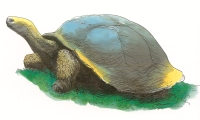| ________________
CM . . .
. Volume XIV Number 2 . . . . September 14, 2007
excerpt:
Geared toward history buffs, In the Land of the Jaguar, consisting of 12 chapters, is almost like having two books in one. The main body of the text describes the history- the explorers, leaders, people, colonization and quest for independence, as well as the problems- of each South American country and provides very brief, general information about the geography, major cities, natural resources and industries. On almost every page, readers will find one or more illustrations, totally unrelated to the main text. Instead, these illustrations depict the flora and fauna, the lifestyle of the people- arts, crafts, music and dance, and food- as well as famous people and landmarks. Accompanying each illustration is a paragraph (or two), printed in a smaller font than the main text. Thus, readers get both the historical and the “fun facts” aspects in this book. Gorrell’s writing style will appeal to young adolescents. Her explanations are thorough and make for interesting reading. For example, Gorrell talks about Alexander Selkirk, who, in 1704, was dropped off on a small island west of Chile. He lived alone for four years, fending for himself on the densely forested island before a passing ship picked him up. His story inspired Daniel Defoe to write the novel Robinson Crusoe. Though the main text provides an unbiased view of the historical events described, the sub-text that is paired with the illustrations is what readers will really enjoy. Here Gorrell occasionally infuses the text with a bit of humour. Some examples of topics include salt carvings, soccer, the quest for silver, rare plants and animals, and the contributions of each country to the world.
Rendered in multi-media (watercolor and pen and ink), the illustrations and maps are lively and colourful. A table of contents and a lengthy index are provided. Generally speaking, this is an excellent book, but with its emphasis on history, those students searching for information on a specific country’s climate, geographical features, plants and animals, culture and lifestyle will not find enough information. To search through the sub-text, even with the help of the index, would be too tedious. Recommended.
To comment on this
title or this review, send mail to cm@umanitoba.ca.
Copyright © the Manitoba Library Association. Reproduction for personal
use is permitted only if this copyright notice is maintained. Any
other reproduction is prohibited without permission.
NEXT REVIEW |TABLE OF CONTENTS FOR THIS ISSUE
- September 14, 2007. AUTHORS
| TITLES | MEDIA REVIEWS
| PROFILES
| BACK ISSUES
| SEARCH | CMARCHIVE
| HOME |

